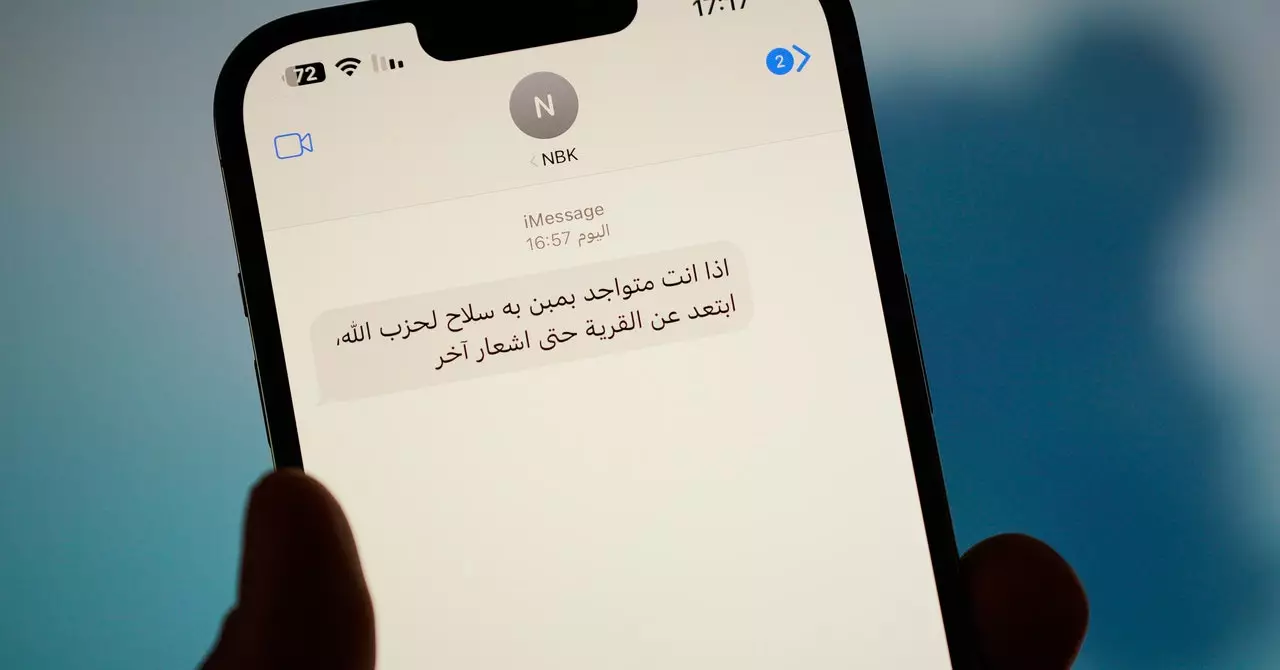On an otherwise mundane evening in Beirut, Nour found herself thrust into a chilling reality when she received an alarming SMS bearing an ominous message: “We have enough bullets for everyone who needs them.” This text, sent in cryptic Arabic, was reminiscent of past hostilities and elicited immediate dread in Nour. Recognizing the sender as likely being Israeli, she refrained from opening the message, fearing it might contain a malicious link. In her account, we witness not just an average individual encountering harrowing threats through modern communication but also a larger narrative of psychological unrest that individuals in Lebanon face during periods of political strife.
The context behind this unsettling message is equally disturbing. This incident occurred in a period of rising tensions following violent exchanges between Israeli forces and the militant group Hezbollah. The clash between Israel and Hezbollah had intensified, with airstrikes leading to significant casualties. This backdrop of violence makes Nur’s situation relatable for many in the region, underlining the war’s ongoing legacy of fear and anxiety. The significance of digital communication in warzones often overlaps with psychological warfare, making such incidents more chaotic and distressing.
Nour’s experience is not an isolated one but rather a continuation of Lebanon’s fraught history with Israeli communication tactics. In the early 2000s, Lebanese citizens received unsettling recorded calls, asking about the fate of missing Israeli airman Ron Arad. Such instances serve as a reminder of how communication can become a tool for manipulation and psychological intimidation. The scars of war remain fresh in the collective memory, where past encounters with officially broadcast messages from Israel continue to evoke feelings of vulnerability and menace.
In 2006, during another violent conflict, Nour heard a recorded message broadcasted over phone lines from a familiar voice, greeting the Lebanese people. These recollections highlight an unfortunate evolution of communication, as technology is weaponized to instill fear. The ties between communication and conflict echo throughout Lebanese history, marking a pattern of alarming messages reminding citizens of their sometimes precarious existence amid the hostilities that surround them.
As the intensity of the conflict escalates, the role of communication through personal devices morphs into a more alarming one. Social media and direct text messages become channels for threats, further amplifying the psychological toll on civilians. Mohamad Najem, an expert in digital rights, notes that during such times, the attachment to phones escalates, as individuals strive for reassurance and connection. However, these devices can also deliver messages that erode the sense of safety, transforming smartphones from instruments of connection into catalysts of anxiety and fear.
The situation is exacerbated by the extensive reach of these threatening communications. Just a week after Nour received her unsettling message, numerous others across Lebanon were bombarded with similarly alarming notifications. Automated messages circulated widely, instilling fear as residents were warned to distance themselves from potential airstrike targets. Such overwhelming waves of unsettling alerts exemplify how widespread panic can be cultivated in an instant through digital channels.
In a broader context, we see that the digital battlefield has emerged as a critical front in the ongoing conflict between Israel and Hezbollah. Civilians on both sides are subjected to threatening messages intended to sow fear, which feeds into the psychological warfare inherently linked to modern conflicts. As troops engage on physical fronts, the personal dimensions of warfare increasingly take place in the intimate spaces of our daily lives, where smartphones become conduits of fear.
Indeed, the emergence of threatening texts and calls paints a grim picture of contemporary conflict, where fear permeates daily life in Lebanon. So, while the individuals receiving these messages are often physically safe at home, the psycho-emotional impact cannot be overstated. Thus, in the landscape of modern warfare, the human cost extends beyond physical destruction, haunting countless individuals with anxiety, apprehension, and a perpetual sense of insecurity that lingers long after the physical battles subside.

